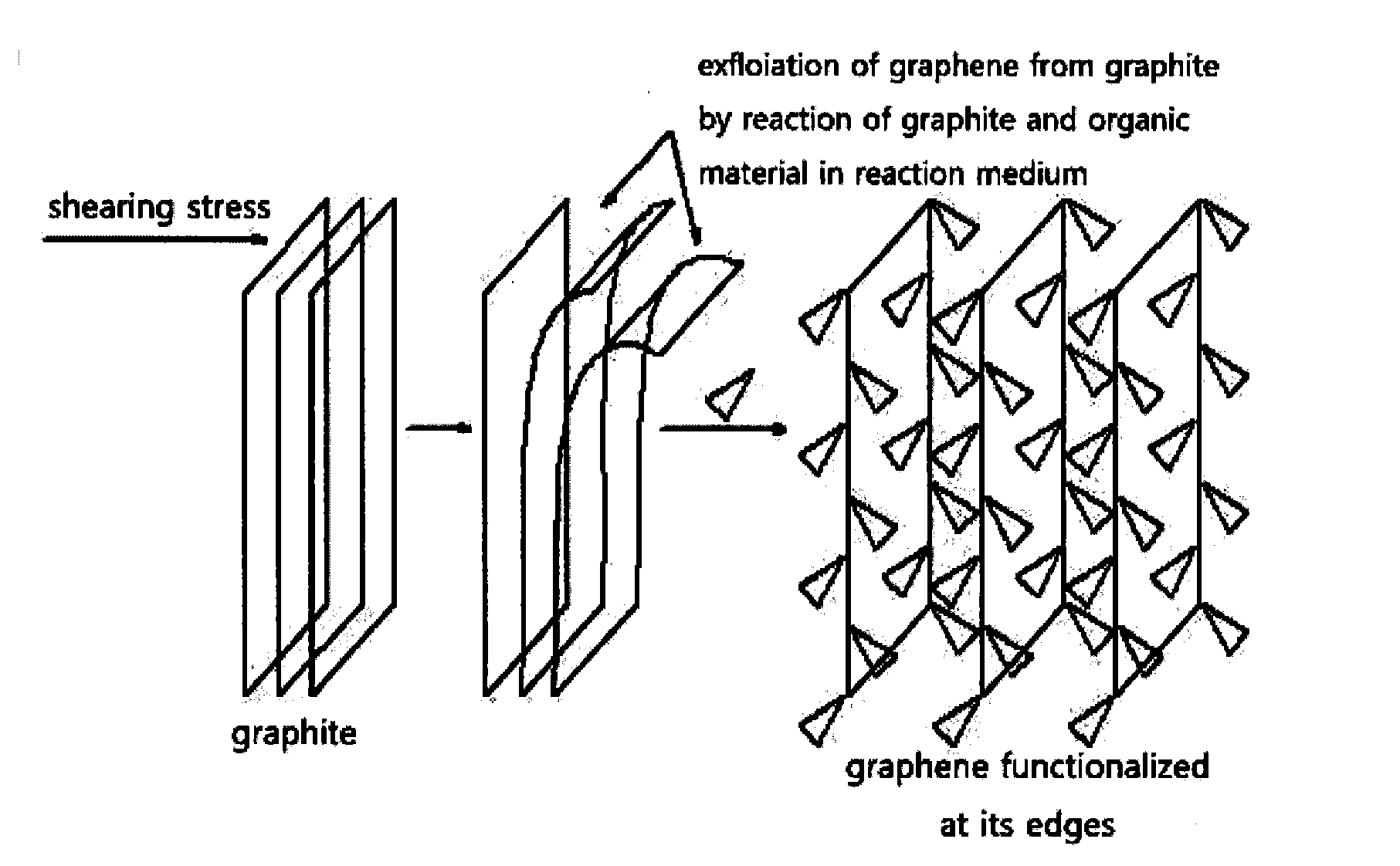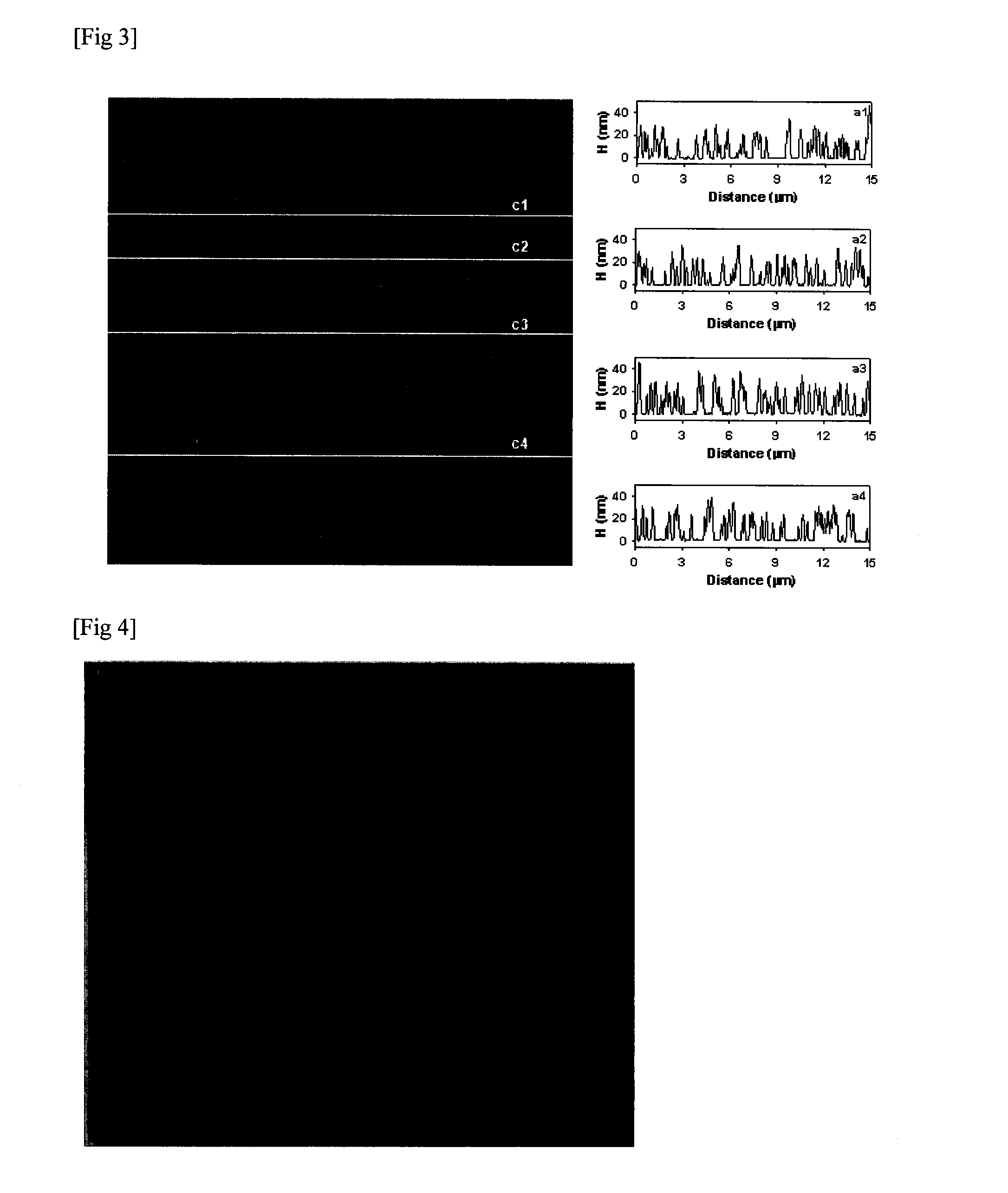Graphene prepared by using edge functionalization of graphite
- Summary
- Abstract
- Description
- Claims
- Application Information
AI Technical Summary
Benefits of technology
Problems solved by technology
Method used
Image
Examples
example 1-1
Preparation of Graphene Functionalized at its Edges
[0072]5 g of graphite and 5 g of amino benzoic acid were added to 110 g of reaction medium comprising 100 g of methanesulfonic acid (CH3SO3H) and 10 g of phosphorus pentoxide (P2O6) from Sigma-Aldrich at a temperature of 100° C. for 72 hours. Or 5 g of graphite and 5 g of amino benzoic acid were added to 100 g of reaction medium comprising trifloromethanesulfonic acid (CF3SO3H) Sigma-Aldrich at a temperature of 100° C. for 72 hours. As a result, bonds of edge positions between graphene sheets were substituted by a covalent bond between the carbon at edge positions of graphene and the carbonyl group of aminobenzoic acid, to functionalize edge positions of graphene.
[0073]After that, the graphene functionalized at edge positions was precipitated in water and it was again recovered and then treated for 3 days in water, and for 3 days in methanol by soxhlet and thereby unreactants such as methanesulfonic acid and phosphorus pentoxide, or...
example 1-2
Preparation of Graphene Functionalized at Edge Positions
[0075]5 g of graphite and 5 g of 4-(2,4,6-trimethylphenoxy)benzamide were added to 110 g of reaction medium comprising 100 g of methanesulfonic acid (CH3SO3H) and 10 g of phosphorus pentoxide (P2O6) from Sigma-Aldrich at a temperature of 100° C. for 72 hours.
[0076]As a result, bonds of edge positions between graphene sheets were substituted by a covalent bond between the carbon at edge positions of graphene and the carbonyl group of 4-(2,4,6-trimethylphenoxy)benzamide, to functionalize edge positions of graphene.
[0077]After that, the graphene functionalized at edge positions was precipitated in water. The precipitated graphene was again recovered and then treated for 3 days in water, and for 3 days in methanol by soxhlet and thereby reaction medium and unreactants such as unreacted 4-(2,4,6-trimethylphenoxy)benzamide were removed. Thereafter, graphene functionalized at edge positions, separated from the above unreactants was fr...
example 2
Separation of Graphene Functionalized at Edge Positions
[0078]0.5 g of freeze-dried products obtained according to the above example 1-1 were dispersed in 500 ml of N-methylpyrrolidone solvent and were agitated for 24 hours.
[0079]And then, dispersed freezed-dried products were centrifugally separated by a centrifugal separator at a rate of 10,000 rpm for 10 minutes to separate graphene functionalized at its edge positions from freeze-dried products.
[0080]Graphene functionalized at its edge positions, obtained by such separation had a width that is more than 2 micrometers and a length that is more than 10 micrometers.
[0081]With regard to this, referring to FIG. 3, FIG. 3 shows the width and length both of the graphene. It can confirm that an exfoliated graphene has its width of more than 2 micrometers and its length of more than 10 micrometers and a molecular wedge type group is attached to only edge positions of graphene.
PUM
| Property | Measurement | Unit |
|---|---|---|
| Temperature | aaaaa | aaaaa |
| Temperature | aaaaa | aaaaa |
| Fraction | aaaaa | aaaaa |
Abstract
Description
Claims
Application Information
 Login to View More
Login to View More - R&D
- Intellectual Property
- Life Sciences
- Materials
- Tech Scout
- Unparalleled Data Quality
- Higher Quality Content
- 60% Fewer Hallucinations
Browse by: Latest US Patents, China's latest patents, Technical Efficacy Thesaurus, Application Domain, Technology Topic, Popular Technical Reports.
© 2025 PatSnap. All rights reserved.Legal|Privacy policy|Modern Slavery Act Transparency Statement|Sitemap|About US| Contact US: help@patsnap.com



